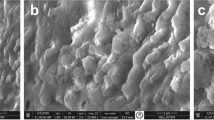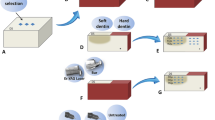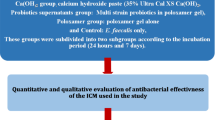Abstract
This study aimed to determine the inhibitory effects of green tea (Gt), EGCG, and nanoformulations containing chitosan (Nchi) and chitosan+green tea (Nchi+Gt) against Streptococcus mutans and Lactobacillus casei. In addition, the antibacterial effect of nanoformulations was evaluated directly on dentin after the selective removal of carious lesion. At first, the minimum inhibitory concentration (MIC) and minimum bactericidal concentration (MBC) against S. mutans and L. casei isolates were investigated. In parallel, dentin specimens were exposed to S. mutans to induce carious lesions. Soft dentin was selectively removed by Er:YAG laser (n=33) or bur (n=33). Remaining dentin was biomodified with Nchi (n=11) or Gt+Nchi (n=11). Control group (n=11) did not receive any treatment. Dentin scraps were collected at three time points. Microbiological analyses were conducted and evaluated by agar plate counts. Gt at 1:32 dilution inhibited S. mutans growth while 1:16 was efficient against L. casei. EGCG at 1:4 dilution completely inhibited S. mutans and L. casei growth. Independently of the association with Gt, Nchi completely inhibited S. mutans at 1:4 dilution. For L. casei, different concentrations of Nchi (1:32) and Nchi+Gt (1:8) were required to inhibit cell growth. After selective carious removal, viability of S. mutans decreased (p<0.001), without difference between bur and Er:YAG laser (p>0.05). Treatment with Nchi and Nchi+Gt did not influence the microbial load of S. mutans on dentin (p>0.05). Although variations in concentrations were noticed, all compounds showed antibacterial activity against S. mutans and L. casei. Both bur and Er:YAG laser have effectively removed soft dentin and reduced S. mutans counts. Nanoformulations did not promote any additional antibacterial effect in the remaining dentin.

Similar content being viewed by others
Data availability
The data supporting the findings of this study are available from the corresponding author on reasonable request.
References
Paes Leme AF, Koo H, Bellato CM, Bedi G, JAC (2006) The role of sucrose in cariogenic dental biofilm formation—new insight. J Dent Res 85:878–887
Bowen WH, Burne RA, Hui W, HK (2018) Oral biofilms: pathogens, matrix and polymicrobial interactions in microenvironments. Trends Microbiol 26:229–242. https://doi.org/10.1016/j.tim.2017.09.008
Ito T, Ichinosawa T, Shimizu T (2017) Streptococcal adhesin SspA/B analogue peptide inhibits adherence and impacts biofilm formation of Streptococcus mutans. PLoS One 12:1–15. https://doi.org/10.1371/journal.pone.0175483
Chen X, Daliri EBM, Tyagi A, Oh DH (2021) Cariogenic biofilm: pathology-related phenotypes and targeted therapy. Microorganisms 9. https://doi.org/10.3390/microorganisms9061311
Kazeminia M, Abdi A, Shohaimi S et al (2020) Dental caries 1995-2019. Head Face Med 1:1–21
Jardim JJ, Mestrinho HD, Koppe B et al (2020) Restorations after selective caries removal: 5-year randomized trial. J Dent 99:103416. https://doi.org/10.1016/j.jdent.2020.103416
Hibst R, Keller U (1989) Experimental studies of the application of the Er:YAG laser on dental hard substances: I. Measurement of the ablation rate. Lasers Surg Med 9:338–344. https://doi.org/10.1002/lsm.1900090405
Keller U, Hibst R (1997) Effects of Er:YAG laser in caries treatment: a clinical pilot study. Lasers Surg Med 20:32–38. https://doi.org/10.1002/(sici)1096-9101(1997)20:1<32::aid-lsm5>3.0.co;2-%23
Valenti C, Pagano S, Bozza S et al (2021) Use of the Er:YAG laser in conservative dentistry: evaluation of the microbial population in carious lesions. Materials (Basel) 14:2387. https://doi.org/10.3390/ma14092387
Nakrathok P, Kijsamanmith K, Vongsavan K et al (2020) The effect of selective carious tissue removal and cavity treatments on the residual intratubular bacteria in coronal dentine. J Dent Sci 15:411–418. https://doi.org/10.1016/j.jds.2020.03.016
Smeriglio A, Barreca D, Bellocco E, Trombetta D (2017) Proanthocyanidins and hydrolysable tannins: occurrence, dietary intake and pharmacological effects. Br J Pharmacol 174:1244–1262. https://doi.org/10.1111/bph.13630
Reygaert WC (2018) Green tea catechins: their use in treating and preventing infectious diseases. Biomed Res Int 2018. https://doi.org/10.1155/2018/9105261
Hairul Islam MI, Arokiyaraj S, Kuralarasan M et al (2020) Inhibitory potential of EGCG on Streptococcus mutans biofilm: a new approach to prevent cariogenesis. Microb Pathog 143:104129. https://doi.org/10.1016/j.micpath.2020.104129
Han S, Abiko Y, Washio J et al (2021) Green tea-derived epigallocatechin gallate inhibits acid production and promotes the aggregation of Streptococcus mutans and non-mutans streptococci. Caries Res 55:205–214. https://doi.org/10.1159/000515814
Elieh-Ali-Komi D, Michael R (2016) Chitin and chitosan: production and application of versatile biomedical nanomaterials. Int J Adv Res 4:411–427. https://doi.org/10.2307/4145104
Kawakita ERH, Ré ACS, Peixoto MPG et al (2019) Effect of chitosan dispersion and microparticles on older streptococcus mutans biofilms. Molecules 24:1–11. https://doi.org/10.3390/molecules24091808
Gu LS, Cai X, Guo JM et al (2019) Chitosan-based extrafibrillar demineralization for dentin bonding. J Dent Res 98:186–193. https://doi.org/10.1177/0022034518805419
Cavalcante LLR, Tedesco AC, Takahashi LAU et al (2020) Conjugate of chitosan nanoparticles with chloroaluminium phthalocyanine: synthesis, characterization and photoinactivation of Streptococcus mutans biofilm. Photodiagnosis Photodyn Ther 30:101709. https://doi.org/10.1016/j.pdpdt.2020.101709
Cánepa C, Imperiale JC, Berini CA et al (2017) Development of a drug delivery system based on chitosan nanoparticles for oral administration of interferon-α. Biomacromolecules 18:3302–3309. https://doi.org/10.1021/acs.biomac.7b00959
Safer AMA, Hanafy NA, Bharali DJ et al (2015) Effect of green tea extract encapsulated into chitosan nanoparticles on hepatic fibrosis collagen fibers assessed by atomic force microscopy in rat hepatic fibrosis model. J Nanosci Nanotechnol 15:6452–6459. https://doi.org/10.1166/jnn.2015.10608
Curylofo-Zotti FA, Tedesco AC, Lizarelli GTC et al (2021) Effect of green tea-loaded chitosan nanoparticles on leathery dentin microhardness. Odontology 109:860–867. https://doi.org/10.1007/s10266-021-00611-6
Marquezan M, Corrêa FNP, Sanabe ME et al (2009) Artificial methods of dentine caries induction: a hardness and morphological comparative study. Arch Oral Biol 54:1111–1117. https://doi.org/10.1016/j.archoralbio.2009.09.007
Curylofo-Zotti FA, Tanta GS, Zucoloto ML et al (2017) Selective removal of carious lesion with Er:YAG laser followed by dentin biomodification with chitosan. Lasers Med Sci 32. https://doi.org/10.1007/s10103-017-2287-6
Curylofo-Zotti FA, Scheffel DLS, Macedo AP et al (2019) Effect of Er:YAG laser irradiation and chitosan biomodification on the stability of resin/demineralized bovin dentin bond. J Mech Behav Biomed Mater 91:220–228. https://doi.org/10.1016/j.jmbbm.2018.12.022
Banerjee A, Frencken JE, Schwendicke F, Innes NPT (2017) Contemporary operative caries management: consensus recommendations on minimally invasive caries removal. Br Dent J 223:215–222. https://doi.org/10.1038/sj.bdj.2017.672
Aguiar TR, Vidal CMP, Phansalkar RS et al (2014) Dentin biomodification potential depends on polyphenol source. J Dent Res 93:417–422. https://doi.org/10.1177/0022034514523783
Jackson JK, Zhao J, Wong W, Burt HM (2010) The inhibition of collagenase induced degradation of collagen by the galloyl-containing polyphenols tannic acid, epigallocatechin gallate and epicatechin gallate. J Mater Sci Mater Med 21:1435–1443. https://doi.org/10.1007/s10856-010-4019-3
Zayed SM, Aboulwafa MM, Hashem AM, Saleh SE (2021) Biofilm formation by Streptococcus mutans and its inhibition by green tea extracts. AMB Express 11. https://doi.org/10.1186/s13568-021-01232-6
Peng HH, Hong DX, Guan YX, Yao SJ (2019) Preparation of pH-responsive DOX-loaded chitosan nanoparticles using supercritical assisted atomization with an enhanced mixer. Int J Pharm 558:82–90. https://doi.org/10.1016/j.ijpharm.2018.12.077
Qin C, Li H, Xiao Q et al (2006) Water-solubility of chitosan and its antimicrobial activity. Carbohydr Polym 63:367–374. https://doi.org/10.1016/j.carbpol.2005.09.023
Hosseinnejad M, Jafari SM (2016) Evaluation of different factors affecting antimicrobial properties of chitosan. Int J Biol Macromol 85:467–475. https://doi.org/10.1016/j.ijbiomac.2016.01.022
Lemos JA, Palmer SR, Zeng L et al (2019) The biology of Streptococcus mutans. Microbiol Spectr 7:1–26. https://doi.org/10.1128/microbiolspec.gpp3-0051-2018
Conrads G, About I, Conrads G, et al (2022) Pathophysiology of dental caries to cite this version : HAL Id : hal-03547399 Pathophysiology of Dental Caries. 1–10
Elburki MS, Rossa C, Guimarães-Stabili MR et al (2017) A chemically modified curcumin (CMC 2.24) inhibits nuclear factor κB activation and inflammatory bone loss in murine models of LPS-induced experimental periodontitis and diabetes-associated natural periodontitis. Inflammation 40. https://doi.org/10.1007/s10753-017-0587-4
Jessa MV, Makabenta AN, Li C-H, Schmidt-Malan S, Robin Patel VMR (2021) Nanomaterial-based therapeutics of antibiotic-resistant bacterial infections. Nat Rev Microbiol 19:23–36. https://doi.org/10.1038/s41579-020-0420-1.Nanomaterial-based
Macià MD, Rojo-Molinero E, Oliver A (2014) Antimicrobial susceptibility testing in biofilm-growing bacteria. Clin Microbiol Infect 20:981–990. https://doi.org/10.1111/1469-0691.12651
Verma D, Garg PK, Dubey AK (2018) Insights into the human oral microbiome. Arch Microbiol 200:525–540. https://doi.org/10.1007/s00203-018-1505-3
Acknowledgements
The authors would like to thank Ana Paula Macedo for assistance with statistical data analysis.
Funding
This study received financial support from the São Paulo Research Foundation (FAPESP), grant nos. #2017/11582-1, #2017/00720-4, #2018/23862-1, #2019/04807-2, thematic project #2013/50181-1 and FINEP project 01.10.0758.01) and from the National Council for Scientific and Technological Development (CNPq), grant nos. PRONON-SIPAR project #25000.077093/2015-86), CNPq-SCTIE-Decit-DGITIS-CGCIS/CNPq no. 26/2020 – Innovative Platforms in Advanced Therapies, # 441673/2020-1 and CNPq-UN # 404416/2021-7, #2021-3/130399.
Author information
Authors and Affiliations
Contributions
All authors contributed to the study conception and design. Material preparation, data collection, and analysis were performed by Fabiana Almeida Curylofo Zotti, Viviane de Cássia Oliveira, Analu Rodriguez Marquesin, and Hiago Salge Borges. The first draft of the manuscript was written by Fabiana Almeida Curylofo Zotti and all authors commented on previous versions of the manuscript. All authors read and approved the final manuscript.
Corresponding author
Ethics declarations
Ethical approval
All procedures performed in the study were in accordance with the Research Ethics Committee of the University of São Paulo (Institutional Review Board protocol CAAE 69600217.4.0000.5419 and with the 1964 Declaration of Helsinki and its later amendments or comparable ethical standards.
Informed consent
Informed consent was obtained from all individual participants who agree to donate their extracted teeth to be included in the study.
Conflict of interest
The authors declare no competing interests.
Additional information
Publisher’s note
Springer Nature remains neutral with regard to jurisdictional claims in published maps and institutional affiliations.
Rights and permissions
Springer Nature or its licensor (e.g. a society or other partner) holds exclusive rights to this article under a publishing agreement with the author(s) or other rightsholder(s); author self-archiving of the accepted manuscript version of this article is solely governed by the terms of such publishing agreement and applicable law.
About this article
Cite this article
Curylofo-Zotti, F.A., Oliveira, V.D.C., Marchesin, A.R. et al. In vitro antibacterial activity of green tea–loaded chitosan nanoparticles on caries-related microorganisms and dentin after Er:YAG laser caries removal. Lasers Med Sci 38, 50 (2023). https://doi.org/10.1007/s10103-023-03707-3
Received:
Accepted:
Published:
DOI: https://doi.org/10.1007/s10103-023-03707-3




